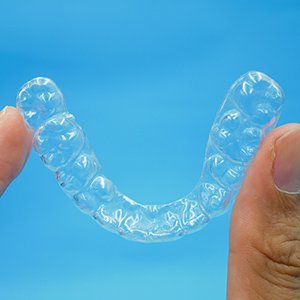Clear aligners are a discreet and removable orthodontic treatment wherein a series of aligners are worn to move teeth to their ideal positions gradually. For a very long time, Invisalign was the only player when it comes to clear aligner treatment. However, it’s always been quite expensive and inconvenient for many people.
Fortunately, multiple at-home teeth straightening kits have become available in recent years, offering patients an affordable and convenient alternative to Invisalign. Have a look at the top teeth straightening options based on cost, reviews, convenience, and customer support below.
Top three affordable teeth straightening kits
- AlignerCo – as low as $945
- NewSmile – as low as $1,495
- Byte – as low as $1,895
Top three teeth straightening kits based on reviews and convenience
- Candid
- NewSmile
- Byte
Top three teeth straightening kits with good customer support
- Candid
- AlignerCo
- NewSmile
What are teeth straightening kits?
Teeth straightening kits are clear aligner systems that you can purchase online without seeing a dentist or an orthodontist and undergo teeth straightening treatment conveniently at home.
It is an attractive option for those who don’t want to wear braces and find it inconvenient to make frequent visits to the dentist to monitor their case. With these teeth straightening kits, you will wear a series of clear aligners to move your teeth to the desired placement, assisted by a network of dentists or orthodontists responsible for your treatment plan. The downside is that teeth straightening kits can only correct mild to moderate teeth alignment issues.
Related post: Quickest Way to Straighten Teeth.
How Do Teeth Straightening Kits Work?
To start with at-home clear aligners, you need to purchase an impression kit. The kit includes putty and trays to create molds of your teeth which will be sent to the company to see if you’re eligible for clear aligners. For some, taking impressions of their teeth at home can be challenging, so some companies, such as SmileDirectClub offer in-office assistance giving customers the option to visit their shops across the U.S., Canada, Europe, and Australia to get a free 3D scan. Whereas for Candid, it’s not an option, and you will have to see a Candid partner dental clinic for assessment.
Behind these at-home aligners is a network of dentists and orthodontists responsible for creating treatment plans, monitoring the progress of every case, and working with you throughout the treatment until you achieve the smile you want. They will track your progress with the photos of your teeth that you’ll upload through the company’s app or email.
Once done, you will have to wear retainers as advised on your treatment plan and should replace them every 6 months.
In-office vs At-home aligners
In-office clear aligners, such as Invisalign, require a dentist or orthodontist to assess whether you are eligible for clear aligners. You are also required to visit the same dental office monthly for them to monitor your progress and make adjustments if necessary.
On the other hand, at-home aligners are suitable for people with busy lifestyles, demanding work schedules, and those who cannot commit to making time for dental office visits. You can have your aligners delivered to your doorsteps and track your progress at home using the brand’s mobile app. Although at-home aligners can only correct minor teeth alignment issues, they are also significantly cheaper than in-office aligners, which is a major factor for many.
Worth Knowing
The survey published in the Journal of the American Dental Association shows that a large majority of respondents (87.5%) were satisfied with their direct-to-consumer (DTC) orthodontic treatment, highlighting the positive impact and effectiveness of these services. However, it’s noted that a small fraction (6.6%) experienced significant adverse effects necessitating professional dental consultation.
Braces vs. At-home aligners
For many years, getting metal braces was the most popular and only way to straighten teeth. However, they’re not among the most comfortable or affordable treatments.
Wearing braces can be very uncomfortable, with wires poking, metal brackets giving mouth sores and extreme discomfort from moving teeth at a rapid pace. For some patients, having metal braces affects their confidence to talk and smile because it gives off what is called a “metal smile”. It also predisposes patients to gum disease because it is harder to do your oral hygiene care routine at home (i.e., brushing and flossing).
According to a survey done by Alansari, R. in 2019, the least preferred orthodontic treatment was colored o-tied-metal-brackets (4%), while clear aligners were the most acceptable appliances among the participants to have placed on themselves (86.9%).
On the other hand, aligners are removable, comfortable, and discreet. Aligners are made of smooth BPA-free plastic with no metal components to cause mouth sores. They are also nearly invisible, and most shouldn’t be able to tell you’re wearing anything. And with the advent of at-home aligners, patients can now start by purchasing an impression kit online and monitoring their treatment comfortably at home by connecting to a network of dentists through the brand’s app.
Worth Knowing
According to research published in Angle Orthodontist, conventional braces typically require more visits and longer treatment time, averaging 5.5 months longer than clear aligner therapy.
Who is a candidate for At-Home Teeth Straightening?
At-home clear aligners are recommended for those with mild to moderate teeth alignment issues such as gaps, crowding, and minor misalignment. Most clear aligners can’t fix severe malocclusions (i.e., overbite, underbite, crossbite) as these cases require adjunct measures such as attachments, rubber bands, expanders, and in some cases, jaw surgery.
People with busy lifestyles, inflexible work schedules, or travel plans may benefit from at-home clear aligners, too, as they can simply update their treatment by uploading photos of their smile depending on when it is required (i.e., every 14 days).

Byte
An affordable option with refundable impression kits, free HyperByte, and a Byte for Life guarantee.
Check out Byte Aligners
Candid
A hybrid of in-office and at-home treatment that provides 1-on-1 orthodontist support.
Check out Candid Aligners
AlignerCo
The cheapest at-home aligners, with monthly plans, no down payment, and considerable discounts.
Check out AlignerCo Aligners
NewSmile
Affordable at-home treatment with positive reviews offering superior look and comfort.
Check out NewSmile AlignersReferences:
Alansari, R., et al. Adult Perceptions of Different Orthodontic Appliances. National Library of Medicine. (2019). Available online at: https://www.ncbi.nlm.nih.gov/pmc/articles/PMC6916694/
Buschang, P.H., Shaw S.G., Ross M., Crosby D., Campbell P.M., Comparative time efficiency of aligner therapy and conventional edgewise braces. Angle Orthod (2014). DOI: 10.2319/062113-466. Available online at: https://meridian.allenpress.com/angle-orthodontist/article/84/3/391/58505/
Wexler, A., Nagappan, A., Beswerchij, A., Choi, R., Direct-to-consumer orthodontics: surveying the user experience, J Am Dent Assoc. 2020. DOI: 10.1016/j.adaj.2020.02.025. Available online at: https://pubmed.ncbi.nlm.nih.gov/32718492/


